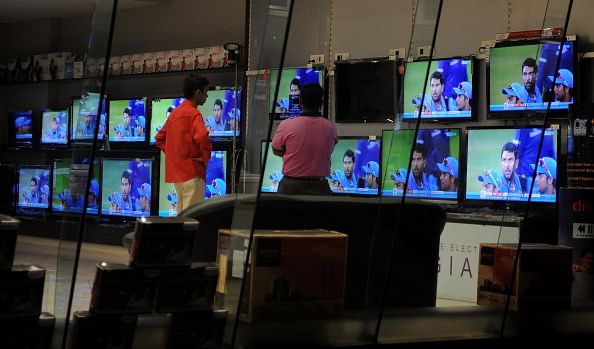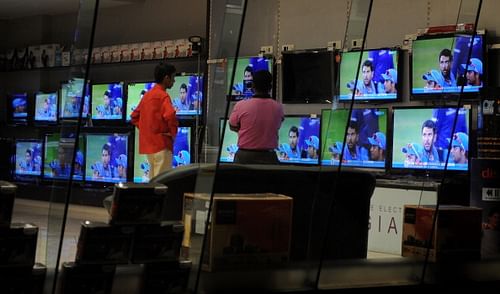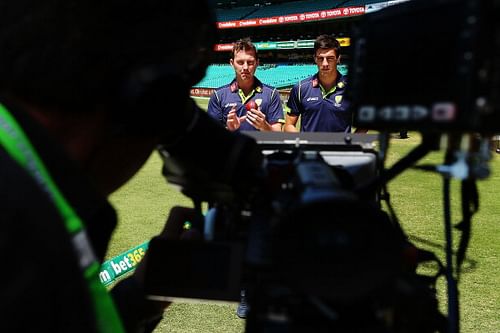
Cricket and the idiot box
Reaching for the twiddling knock in anguish, searching for an elusive short range frequency, listening, entranced by the elegant and impeccable accents of Trevor Bailey or Brian Johnston. Surjit Singh, Latika Ratnam on the other hand, aspired to their English contemporaries. If BBC was afloat with an old empire style of English, the AIR did a decent job in enthralling the Indian listeners.

To the confounded ones, I’m talking about the handy, vintage device that transmits and receives electromagnetic waves, the radio. Hitherto, it has been the most sensational invention by man. Quiz your dad or grandfather, they would vouch for it. As against the pageantry devices today, it was simple and was the source of adrenaline rush for a million.
As astounding as it sounds, there was a time when the game was listened to. So lucid and insightful were the voices that echoed in a million households. Till date, my father gives me a salubrious account of Gavaskar’s art of batting. Articles abound on how Gavaskar grilled the Windies and how he negotiated the deadly trio. All this were listened to, more than it was watched. It is hard to imagine; listening to a cricket commentary and yet being an expert of the game takes a genius. The voices that went on air take the credit. There are connoisseurs who would give you a ball by ball account of the 1983 World Cup finals or even the Wimbledon finals where Jimmy Connor’s game was destroyed by Stan Smith and Arthur Ashe. My grandfather reminisces every sound that came from his pet box, the radio. Listening to the proceedings on the radio became inevitable and was sort of an addiction, to the extent that even spectators in the stadiums had a radio close to their ears. They were accustomed to the commentary – the ‘running in’ and ‘played back past the bowler’.
Change is the only constant they say, and history stands testimony to it. In the early or mid 80s, the handy portable box, the friend of yesteryear was being jettisoned. People who lurched on the rugged streets, carrying bat-shaped wooden pieces and a near spherical ball made by folding rubber tubes, now got a detailed account of the action. The game that was once being imagined, with just audio aide, was now lived. For the millions, watching Gavaskar’s off drive, they once listened to, was like reaching nirvana of sorts. The television then forayed into the entertainment industry and soon went on to become a household member, usurping the radio. The audiences were seeing everything they were hearing and television’s enticement grew manifold. The viewers were thoroughly mesmerised. Elucidating the state of mind of those who caught the action unfold on the TV sets is too tough and takes a better writer. Watching Gavaskar bat, Kapil Dev bowl, Viv Richards pull, was as bewitching as it sounds. Doordarshan, the most used term of the mid late 80s and early 90s, had a monopoly of telecasting the matches.
In the story of hockey’s decline and cricket’s rise, television was the protagonist. It was hockey that symbolised the ability of Indians to compete and excel on the global stage. We won gold after gold medals in Olympics and the greatness of Dhyan Chand surpasses the greatness of most Indian cricketing heroes today. Yet, between Dhyan Chand and Dhanraj Pillay, hockey took too many beatings and rubbing salt to the wound, we regularly started losing to Pakistan, an arch enemy on and off the field. Even today, after years of cricket with Pakistan, a loss to Pakistan is a huge setback and causes more chagrin than it does on losing against any other team in the world. Luckily, India has routed Pakistan in every World Cup encounter. In hockey, the tale was different. We started losing to Pakistan more often than we won and the losses often occurred at big stages. On the other hand, cricket rose through the ranks and Kapil Dev was up there, holding the shiny World Trophy on which shimmered with the joys of a billion. The picture is vividly intact in the minds of every Indian. People wanted to watch India win and cricket was an automatic option. The funeral of hockey wasn’t far of and the birth of cricket happened simultaneously.
Today, the relation between the camera and the game is so wholly shaped that it is hard to realise cameras were once absent from the sport. The cameras began recording Gavaskar in black and white and today, even the budding cricketers find their faces captured by it. The journey of television in cricket encompasses many a milestone and tombstone. Initially, cricket associations made no money from the television and today, the major chunk of the revenue is made from the idiot box. The ground spectators are no more made the primary aim by the organisers. The marketers of the game have set their sight on the TV audience and do every bit they can to enthral them. Cameras have mutated, and so has the viewing experience. Yet, the facilities at the grounds have been paltry and outrageously bad for the health of the spectators.

Cricket and the television are entwined in a way that no other team game is. Cricket is one game that is viewed better and clearer on TV than at the stadium. Thanks to the zooming levels and the lenses that have supported it. In cricket, the action is centred and confined in the twenty two yard strip and in the middle of the ground. The ball travels at 100 odd kilometers per hour until it reaches the bat and every shot happens in a jiffy, faster than a human eye can take note of. Whereas in games like football, in the stadium, you get a broader view of the action than on the television. Hence, cricket is tailor made for the television. The speed of the action paved way to the TV umpire and this emphasises the importance of television.
Jumping to the financial aspects of the game, no other game is as modular as cricket is. As in, no other game has set of six balls grouped together as in cricket. This provides an automatic slot for the commercial breaks. A tenth of the ads aired during a cricket match aren’t aired during a football game. Hence, the most powerful bigwigs of the game, the marketing gurus, struck an instant chord with television. The television bolstered cricket than it did any other sport.
Today, watching Tendulkar swaddling down the ground to take guard is a doorway to heaven for most spectators. The best sporting contests have been caught by the camera, like Tendulkar waltzing down the ground to Warne. We saw Warne turning the ball, we saw Mcgrath swinging the ball, we saw Waqar reverse swinging it, and we saw Dhoni hitting a six to seal a World Cup win. The very camera caught the Pakistani cricketers off guard, unearthed a major scam in India. The camera recognized the smallest of kinks and called Akthar for chucking when on the other hand, it recorded the rhythmic brilliance of Mcgrath. We saw them all and there is more around the corner.
The camera today is a stern God and it demands complete submission. The BCCI is at loggerheads with the world in trusting the camera to a deeper extent, the UDRS. The Indians, who engulfed and espoused change, are producing today dismal excuses for embracing the UDRS. The television can be credible than an on field umpire, the simple truth is hidden beneath minute scientific evidences. The Snickometer, the Hawk eye, and the Hot Spot are elaborations of the close up and make an abstruse game with ambiguous and intricate laws more graphic and explicit.
When hearing was believing, seeing became bewildering. Hence, television construed to be a peripheral, is what forms the backbone of the game today. The seductiveness of the game, the delicacy of the game, the artistry of this beautiful game meets the eye today. Thanks to the television, the idiot box. The true nature of the society shows its head in its naming as the Idiot box.